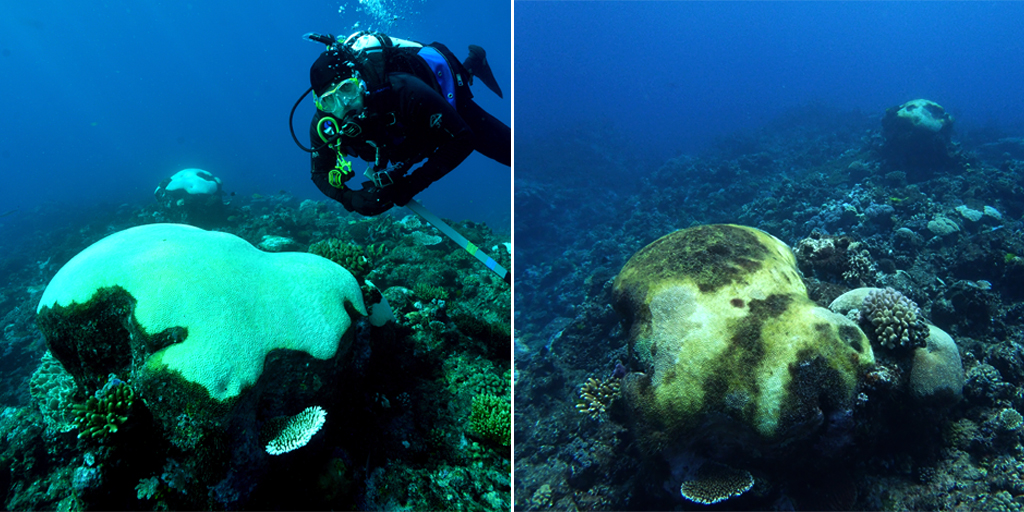Today, a high-level summary of post-bleaching survey results of the Great Barrier Reef (GBR) was released, providing the first comprehensive picture of the extent and geographic variance of coral loss resulting from the most severe mass bleaching event on record. The key findings to emerge shed light on coral mortality and survivorship, and conclude:
- the worst hit region is the northern third of the Reef – north of Port Douglas – where on average, more than half of the bleached corals died;
- the bottom two-thirds of the Reef – south of Port Douglas – suffered minimal or no mortality; and
- most importantly, mortality due to the bleaching varies between regions, between reefs within a region, and on individual reefs the deeper corals were less affected.
A Platygyra brain coral colony at Agincourt Reef that suffered severe bleaching in June (left) was found dead in September (right), six months following the heat stress. On average, more than half of the bleached corals in this northern sector have died. Image: AIMS
Coates Reef, just south of Cairns with 30-60% of the coral community bleached in April (shown on the left). The same community on the reef slope had recovered by September. Image: AIMS
Alongside scientists from the ARC Centre of Excellence for Coral Reef Studies, staff and managers from the Great Barrier Reef Marine Park Authority and the tourism industry, researchers from the Australian Institute of Marine Science (AIMS) have spent the last five months surveying the GBR to assess changes in living coral cover to understand the consequences of this major bleaching event for resident coral reef communities.
In addition, using leading-edge technology, AIMS has captured oceanographic data to assist in understanding the observed regional variations in temperature and bleaching. The underlying causes for the reported differences in bleaching and mortality are the subject of research and analyses currently underway at AIMS, but are likely due to a combination of prolonged exposure to heat stress and the specific tolerance level of the local coral communities.
To learn as much as possible from the bleaching event, AIMS is committed to studying the recovery processes in detail. Even within the worst affected northern GBR, bleaching severity, mortality and survival at some sites was observed to be better than average. In the next few years, AIMS seeks to understand the environmental characteristics of these reefs and the surviving coral species. This enables scientists to better predict the future resilience of reefs - on the GBR and elsewhere. Innovative research is underway at AIMS that responds to this need by examining survival dynamics, including bleaching tolerance and adaptation.
In February, AIMS will provide a whole of GBR condition report based on the AIMS’ Long-term Monitoring Program 30 + year dataset. This will provide a comprehensive analysis of how the bleaching, as well as other pressures such as COTS and cyclones, have affected the Reef’s coral communities.
The 2016 global coral bleaching event has undeniably affected the composition and diversity of coral reef communities of the GBR. Driven by the record-breaking ocean temperatures that exceeded typical summer maxima for prolonged periods of time, the impacts far exceed those of previous mass bleaching events in 1998 and 2002. AIMS is currently using analyses of long-lived corals from the AIMS Coral Core collection in order to put the frequency of recent bleaching events into the long-term context of the past 400 years for the GBR.
For more information, please contact:
Dr Britta Schaffelke
Research Program Leader
Australian Institute of Marine - Townsville



